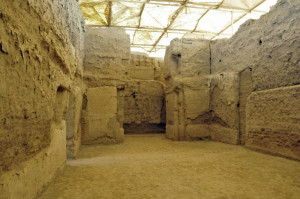
Throne Room of Mari Palace (Photo by Don Knebel)
Mari, founded in about 3000 B.C., was disposed within a circular embankment. It grew rich as the center of trade between Babylon and cities to the north and west, including Hazor, later rebuilt by King Solomon. By 1800 B.C., Mari controlled an area extending from the northern reaches of Babylonia to the southern border of what is now Turkey. The city itself, covering more than 150 acres, featured a spectacular palace, occupying more than 300,000 square feet and including about 275 rooms.
In 1760 B.C., Babylonian King Hammurabi conquered Mari, burned its palace and took control of the surrounding territory. Six years later, Hammurabi issued a famous code governing the administration of justice in the areas he controlled. The code, which Hammurabi attributed to Babylonian gods, sets out the retributive punishment of an “eye for an eye, a tooth for a tooth” that is repeated in the Hebrew Scriptures and later rejected by Jesus.
The Mari ruins were buried under the desert sands and forgotten until 1933, when French archaeologists rediscovered the city and began excavations. They uncovered a royal archive of about 15,000 clay tablets with cuneiform writing in the demolished rooms of the palace. Some of the tablets described places associated with Biblical Abraham. Others included prophecies made in the name of the gods, a practice once thought to have originated with the Hebrew prophets. All provided unprecedented information about life in the lands of the Bible during the early second millennium B.C.
Mari has been the victim of looting and destruction during Syria’s civil war. Fortunately, what has been learned from its tablets cannot be destroyed.
Comments are closed.